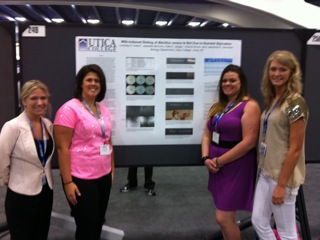
Milk-Induced Sliding of Bacillus cereus Is Not Due to Nutrient Starvation
L. E. Avery, J. McCorry, K. E. Zeigler, V. Bruns, L. R. Aaronson
Bacillus cereus is a gram-positive rod-shaped bacterium commonly found in soil, and is often a contaminant of unpasteurized milk resulting in GI infection in humans. B. cereus is a motile bacterium and exhibits several forms of motility: swimming in liquid media, and swarming and sliding on moist surfaces. Swarming results from hyperflagellation and occurs on nutrient-rich media with smooth-edged colonial morphology. Sliding motility is aflagellar, has been shown in some bacterial species to be a starvation response and is characterized by spreading dendritic growth. We have observed that B. cereus exhibits sliding motility only on agar media containing cow’s milk where the bacteria exhibit distinctive dendritic growth. The transcriptional regulator, PlcR is known to regulate motility in B. cereus through control of the expression of flagellar proteins; a deletion mutant of plcR exhibits sliding. PlcR also activates expression of exoproteases (EP) and hemolysin genes, which are also repressed by CcpA protein when glucose is abundant. B. cereus cannot utilize lactose as a carbon source and employs peptonizaton of casein for growth, so it is possible that poor nutrient availability causes sliding motility. Therefore, we hypothesize that the addition of glucose to milk agar will suppress sliding as CcpA represses expression of nutrient-scavenging enzymes, and PlcR induces swarming motility. B. cereus was spot inoculated onto 1.5% agar plates with varying combinations and concentrations of milk, tryptone, sheep’s blood and glucose, and incubated at 30oC for up to 48 hrs. Growth on plates was observed, and cells from the edges of colonies were collected for RNA extraction. RT-PCR was performed using primers for EP, ccpA, hblA, fliC and plcR. Results show that sliding occurs on plates containing whole or diluted milk, as well as on milk + 1% glucose and milk + 3% sheep blood. No sliding was observed on tryptone, TSA+blood agar or chocolate agar. RT-PCR studies indicate no expression of plcR RNA in sliding cells, though expression of hblA and EP RNA was evident. Low levels of expression of fliC and EP were seen in cells grown on milk + glucose. These data suggest that one or more components of milk induce sliding in B. cereus through undetermined signaling pathways, and that sliding is not a carbon starvation response in this organism.

